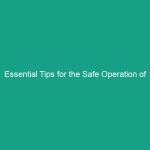Introduction
Good morning team! Today, we are going to discuss an incredibly important topic that affects all of us in the workplace: Essential Transportation Safety Tips: Avoid These Critical Risks Today. Transportation Safety is not just about following the rules; it’s about ensuring that each one of us goes home safe at the end of the day. By understanding the risks and implementing Best Practices, we can create a safer working Environment for everyone.
Understanding Essential Transportation Safety Tips
So, what exactly are Essential Transportation Safety Tips? These are guidelines designed to help employees minimize risks associated with transportation in the workplace, whether it involves driving vehicles, operating machinery, or even moving materials. Transportation safety is crucial because it directly impacts our daily operations, productivity, and overall well-being. Ignoring these tips can lead to serious accidents, injuries, and even fatalities, which is something we all want to avoid.
One common misconception is that safety is only the responsibility of supervisors or safety officers. In reality, each of us plays a vital role in maintaining a safe transportation environment. We must all commit to following safety protocols and looking out for one another.
Key Hazards, Risks, and Safety Considerations
- Vehicle Collisions: One of the most prevalent Hazards in transportation is the risk of vehicle collisions, whether on the road or within the workplace. These can occur due to Distracted Driving, speeding, or not following established routes.
- Equipment Malfunctions: Faulty machinery or vehicles can lead to severe accidents. Regular Maintenance and inspections are essential to prevent these malfunctions.
- Environmental Conditions: Weather conditions such as rain, snow, and fog can significantly affect driving conditions. It’s crucial to adjust your driving habits accordingly.
- Load Safety: Improperly secured loads can lead to spills and accidents. Always ensure that loads are balanced and secured before transportation.
Ignoring these risks can lead to real-world consequences such as injuries, property damage, and even legal repercussions. Each of us must recognize these hazards and take proactive measures to mitigate them.
Best Practices, Procedures, & Actionable Advice
Step-by-Step Safety Procedures
To ensure safety while transporting materials or driving vehicles, here are some essential procedures to follow:
- Conduct Pre-Trip Inspections: Before operating any vehicle or equipment, perform a thorough inspection. Check tires, brakes, lights, and fluid levels.
- Use Seatbelts: Always wear your seatbelt, no matter how short the trip. Seatbelts save lives.
- Follow the Speed Limit: Adhere to posted speed limits, and adjust your speed according to road conditions.
- Stay Focused: Avoid distractions while driving. This includes using your phone, eating, or any other activity that diverts your attention.
- Secure Loads Properly: Use straps, nets, or other securing devices to ensure that all loads are stable and secure before transportation.
Real-Life Examples
Let’s look at a couple of real-world incidents to illustrate the importance of these safety practices:
- In one case, a warehouse employee was seriously injured when a load fell from a forklift. The investigation revealed that the load had not been secured properly, highlighting the critical need for proper loading procedures.
- Another incident occurred when a driver was distracted by their phone and collided with another vehicle. This incident could have been avoided if the driver had adhered to the practice of staying focused while driving.
Regulations, Standards, and Compliance
It’s essential to understand the Regulations that govern transportation safety. Organizations like OSHA (Occupational Safety and Health Administration) set Standards to ensure safe transportation practices. Compliance with these regulations is critical not only for avoiding fines but also for protecting yourself and your coworkers.
By adhering to the relevant regulations, we can create a safer workplace and reduce the chance of accidents. Remember, safety compliance is a shared responsibility, and it starts with each one of us.
Employee Engagement & Discussion
Now, I want to hear from you. What safety challenges have you encountered related to transportation? Are there specific situations where you felt unsafe? Let’s open the floor for discussion. Your experiences can help us improve our safety practices and learn from one another.
Conclusion & Key Takeaways
To wrap up, let’s quickly summarize the main safety points we’ve discussed today:
- Always conduct pre-trip inspections.
- Wear seatbelts and follow speed limits.
- Stay focused and avoid distractions while driving.
- Secure loads properly to prevent accidents.
- Understand and comply with safety regulations.
Implementing these Essential Transportation Safety Tips can significantly reduce risks and improve our overall Workplace Safety. Remember, safety is not just a policy; it’s a culture we must all embrace. Thank you for your attention and for your commitment to making our workplace safer!


